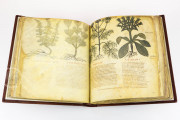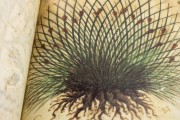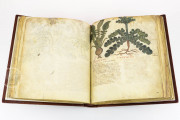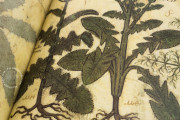The seventh-century Naples Dioscorides is among the most ancient manuscripts of the Materials of Medicine, the most popular medical work from Greco-Roman antiquity. The text was composed in the first century CE by the Greek surgeon Pedanius Dioscorides. The codex is truly remarkable for its 304 botanical illustrations and extremely detailed plant descriptions.
A Medieval Best-Seller
Dioscorides was a major authority in his field, as witnessed by the widespread dissemination of his work. In the sixth century, the opus was translated into Latin; from the ninth century onwards, Arabic, Syriac, and Hebrew versions also appeared. The Materials was thus the medical point of reference for doctors throughout the West and the East and was read by physicians and botanists alike. The Naples Dioscorides dates to the early seventh century, even though scholars are still unsure whether it was made in Italy or Byzantium. Professor Cavallo sees the manuscript's illustrations as the clear product of Greek artists in Italy.
The Miniatures: Tradition Renewed
According to some scholars, the botanical and pharmaceutical illustrations of the Naples Dioscorides could be copies of more ancient models. Among the earlier illustrated texts Dioscorides might have consulted is the herbal of Crateuas, a text that falls in the field of Alexandrian and Pergamene textbooks of the second and first centuries BCE. One, two, or three depictions of plants occupy the upper half of each page, the lower half containing explanatory texts. The verso pages are mostly blank or only bear brief text, thus avoiding writing over the color that shows through the parchment from the illustrations.
Legibility and an Aid to Readers
The script used in the Naples Dioscorides is Biblical Majuscule, an extremely readable Greek book hand. Each botanical illustration is followed by the name of the plant in red ink, another aid to legibility. Several annotations and marginalia in the codex testify to the Neapolitan manuscript's popularity through the centuries.
A Textbook for Physicians and Surgeons
In each chapter, Dioscorides describes a single plant. The plant's name is first given (with many synonyms); then, its properties are described together with its pharmacological use in the healing of specific diseases. This makes of the Naples Dioscorides both a botanical work and a pharmacological work, conceived as a textbook on drugs to be used by doctors and surgeons. The order in which each plant appears in the text is purely alphabetical: a systematic order based on the therapeutic properties of each specimen was forced out in favor of a more user-friendly arrangement.
A Mysterious History
Little is known about the history of the Naples Dioscorides. Up to the eighteenth century, it was preserved in the Augustinian monastery of San Giovanni a Carbonara in Naples. In 1718, the Hapsburg family moved it to the Viennese court library: in 1919, after the peace negotiations following World War I, the codex was brought back to Naples, this time to the Biblioteca Nazionale, where it is still preserved today.
We have 2 facsimiles of the manuscript "Naples Dioscorides":
- Dioskurides Neapolitanus facsimile edition published by Akademische Druck- u. Verlagsanstalt (ADEVA), 1988
- Dioscurides Neapolitanus facsimile edition published by Salerno Editrice, 1988



























